Abstract
Optimization and improvement of the electrical system are applied to cope with the increased demand for electrical power in the vehicular system; they must be carried out in many ways to ensure that the vehicles are provided with the necessary electricity for their performance work electrical equipment. This paper reviews the various optimization approaches for the alternator used in automotive applications and discusses the advantages and disadvantages of each method. The optimization is achieved to the field excitation current that influences the alternator output voltage, and the other techniques designed a controller to optimize the output power of the alternator using power electronic converters. The most suitable approaches are those approaches that use real-time optimization and self-optimization methods. Combining the above two methods can achieve the best results, higher efficiency, stable performance, and a large amount of power produced by the alternator.
1. Introduction
The power demand was not a concern for decades because the only consumers were electrical ignition, lights, and windshield wipers, and extras like radio and electrically operated fans were only available in higher-end automobiles. However, the extra equipment installed in the vehicles forced the car industry to search for solutions to increase the power generation. One of these solutions is using optimization techniques. Some optimization techniques cannot achieve optimum fuel usage due to the many components of the vehicle’s electrical system. Other optimization methods rely on a precise driving cycle. As a result, real-time recognition of actual driving conditions is the most excellent technique to achieve excessive fuel consumption and poor electrical system performance. As it is applied in the research by [1], they studied the impact of speed changes on the output voltage, current, and power for the automotive alternator. The optimization methods and techniques are found in the most modern research, and industrial car companies apply them. The summary of the battery power related to the load for the autonomous system is in Table 1. In [2], various excitation methods of double starter-alternator are investigated to overcome the problem of single stator design. The authors [3] discussed energy consumption, management, and recovery as essential considerations in automotive systems considering future trends.

Table 1.
Summary for the power demand associated with the load for autonomous systems.
Moreover, linear alternator design is reviewed in [4]. In addition, switch reluctance alternators for automotive applications are reviewed by [5,6]; they included modeling, design, simulation, analysis, and control, among other topics. In addition, the authors [7] investigated the effect of idling on fuel consumption in a truck. Moreover, a review of the various power sources in hybrid vehicles using multi-input DC-DC (DC stand for direct current) converter topologies is given in [8]. An overview is presented in [9] to discuss electric power conversion and its power electronics digital control for new functions on board automobiles. Solutions to enhance hybrid electrical vehicles’ performance and power efficiency are survived in [10] using three types of alternators. An overview of the various AC machines (AC stands for alternating current) in hybrid electrical vehicles (HEVs) is investigated in [11]. Furthermore, a comprehensive review of modeling and control has been presented in [12] for hybrid electric vehicles. This paper focuses on two main subjects: the various optimization techniques and the second one is power electronic techniques used to enhance the performance of the vehicle’s alternators. An extensive analysis is achieved to explain the principle for each method and investigate the advantages and disadvantages of each approach.
2. Optimization Methods
Many techniques are used in literature, and they are presented in detail below.
2.1. Pontryagin’s Minimum Principle (PMP)
The authors in [13] designed a supervisory energy management strategy using an adaptive Pontryagin’s Minimum Principle (PMP) optimization algorithm. This strategy commands the alternator duty and reeds the instantaneous load current to optimize the fuel economy by constraining the battery’s voltage and state of charge (SOC); the PMP algorithm commands the alternator duty cycle to decrease the vehicle’s fuel consumption. It captures the energy spent by the alternator and the dynamics of bus voltage, battery charge, and electricity. In the general control strategy, a command is signaled to the field circuit of the alternator via its field current, and the output load current will be enhanced by increasing this current. The experimental platform for the proposed system is in Figure 1.
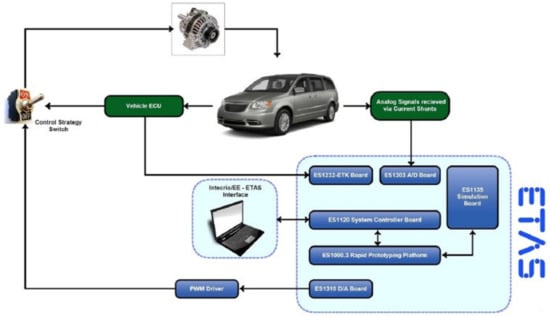
Figure 1.
Block diagram for the experimental test rig [13].
The proposed PMP algorithm is seen in Figure 2.
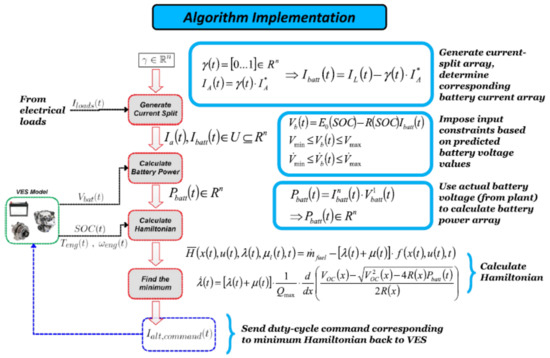
Figure 2.
Block diagram of PMP control algorithm [13].
Figure 3 below illustrates the SOC for the battery when the PMP algorithm is applied; in addition, a comparison is achieved in Figure 4 below to show the effectiveness of using the proposed algorithm compared with electrical voltage regulation (EVR) for the battery and alternator current.

Figure 3.
Result for state of charge of the battery using the proposed algorithm [13].
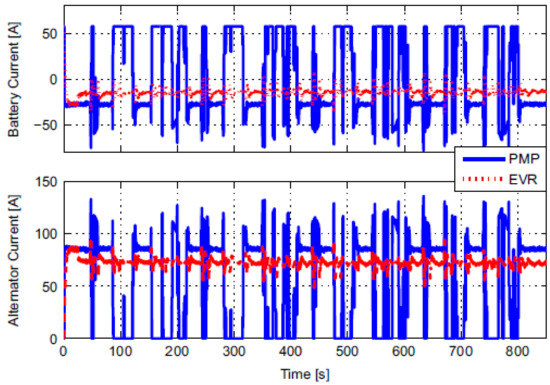
Figure 4.
Battery and alternator current for the PMP and EVR algorithms [13].
Figure 5 below illustrates that the output voltage for the PMP approach has more ripple than that in the EVR approach.
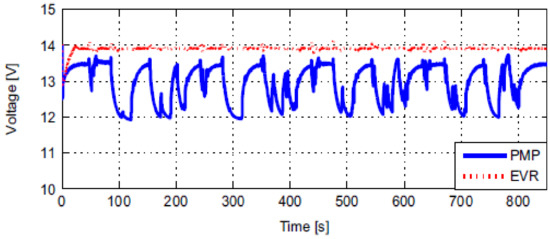
Figure 5.
Battery and alternator current for the PMP and EVR algorithms [13].
Furthermore, the authors modified their algorithm to an adaptive algorithm for PMP to obtain an optimal solution for the fuel consumption problem. Unlike the previous method, the control parameters are tuned in this adaptive algorithm. Figure 6 is for the structure of the adaptive PMP algorithm.
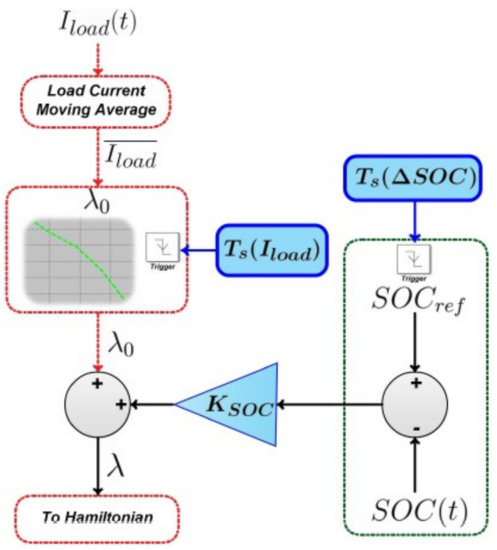
Figure 6.
Flowchart for adaptive PMP algorithm [13].
2.2. Optimal Power Distribution (OPD)
Optimal power distribution OPD optimization is introduced to solve this problem in real-time performance. The proposed control method changed the intelligent alternator and the battery outputs during the load change and variation in driving conditions during real-time operation [14]. In a real-time manner, an intelligent battery sensor (IBS) collects the current and voltage information and evaluates the SOC for the battery. The intelligent alternator will conduct four modes of operation: the sleep or ready mode, the pre-excitation mode, voltage regulation mode, and finally, the off excitation mode. The alternator mode of operation is seen in Figure 7.
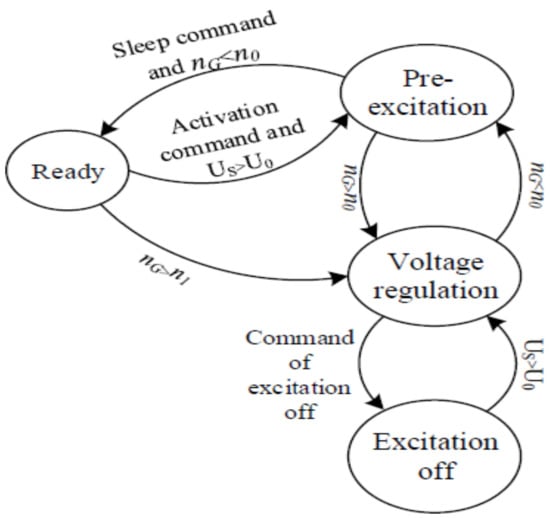
Figure 7.
Modes of operation for the intelligent alternator [14].
The primary purpose of the power management controller is to keep the battery in a usable mode that will provide the load with the required energy and minimal usage for the fuel using the switching on and off for the excitation of the alternator. In Figure 8, the flowchart for the used optimization algorithm is demonstrated.
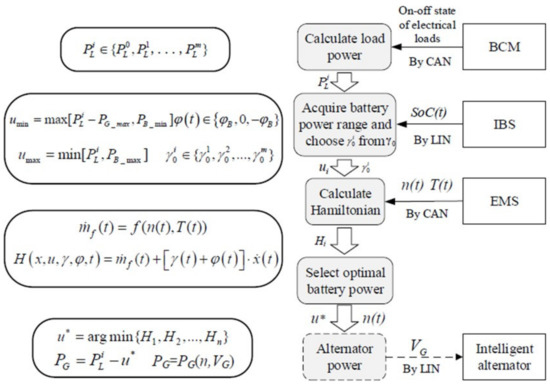
Figure 8.
Flowchart for the OPD optimization algorithm [14].
Figure 9 below represents the results for the battery voltage, SOC, and the power for the battery, load, and battery when applying the proposed algorithm.

Figure 9.
Experimental results for the proposed algorithm (a) alternator voltage, (b) battery SOC, and (c) alternator, load, and battery power [14].
2.3. Equivalent Consumption Minimization Strategy (ECMS)
Another supervisory energy management algorithm was proposed based on the “Equivalent Consumption Minimization Strategy” (ECMS) [15]. The optimization problem is to ensure economic fuel consumption for the vehicle by controlling the duty cycle of the alternator, and the constraints are the battery SOC, voltage, and load current. The baseline control algorithm is an essential voltage regulator that regulates the alternator duty cycle using a PID (Proportional, Derivative, and Integral) controller. The scheme of the alternator controller method is presented in Figure 10 below.
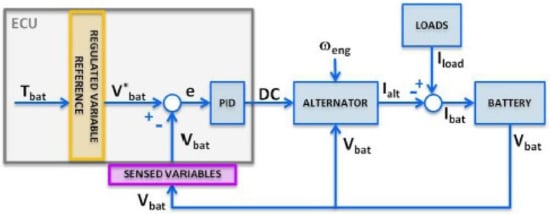
Figure 10.
PID controller for alternator voltage regulator [15].
A penalty function ensures that SOC for that battery does not exceed the desired values. Finally, the alternator current, battery voltage, current, and SOC results are seen in Figure 11 below.

Figure 11.
Simulation results for the proposed algorithm [15].
2.4. Model Predictive Controller (MPC) and Modified Dynamic Programming (DP)
In an alternator/battery combination, there is a freedom for the alternator to decide when the power will have generated, but this freedom is not used. The authors [16] used this freedom to design energy management controllers that reduce fuel consumption. A simple power management controller is seen in Figure 12.
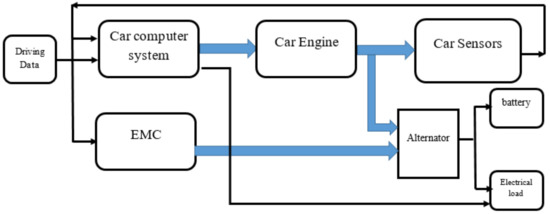
Figure 12.
Energy management controller for the vehicle “Reprinted from [16]”.
The optimization is used in this work because it will provide better power management and high efficiency for the alternator compared with other fuzzy or rule-based algorithms. First, a further simplification of the vehicle model results in a more straightforward quadratic programming (QP) structure being reduced to the problem formulation. Secondly, a strategy is drawn up based on the QP formulation, which requires historical and present vehicle information. Finally, the Model Predictive Control (MPC) is used to predict the future behavior of the power system.
The authors also apply the MPC control method in [17] that used belted starter-alternator (BSA). Nonlinear modeling for the starter-alternator is performed. Then, MPC linear controller is designed to track the desired engine speed. In this paper, the MPC controller aimed to control the alternator starting torque to get the wanted start-stop performance, and simultaneously, it considered the constraint of the starting torque. The block diagram for the controller is shown in Figure 13.

Figure 13.
MPC block diagram for the BSA “Reprinted from [17]”.
2.5. Teaching-Learning-Based Optimization (TLBO)
A new optimization technique was introduced to regulate the alternator’s output voltage as an automatic voltage regulator (AVR) in [18]. This algorithm is called teaching learning-based optimization (TLBO), and it is implemented to evaluate the optimal gains for the PID controller. Good voltage response is optioned by using this algorithm. The authors used fuzzy logic to obtain the dynamic online performance for online performance. The core of the current work indicates that the suggested TLBO approach may have been successfully applied to the AVR power system. Figure 14 shows the transfer function for the proposed model.
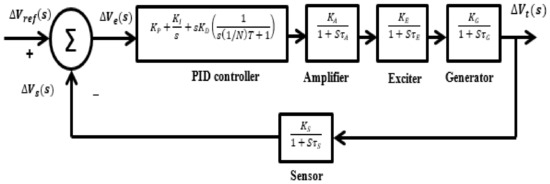
Figure 14.
Transfer function block diagram of the proposed system “Adapted with permission from [18]”.
The objective function is a time-domain objective function, and the constraints are the PID gains values and the time constant of the system. Figure 15 below represents the step response for the percentage variation of the per-unit output voltage under variation for the four-time constants (for the amplifier (τA), for the exciter (τE), for the generator (τG), and the sensor (τS)) for the robust TLBO algorithm.
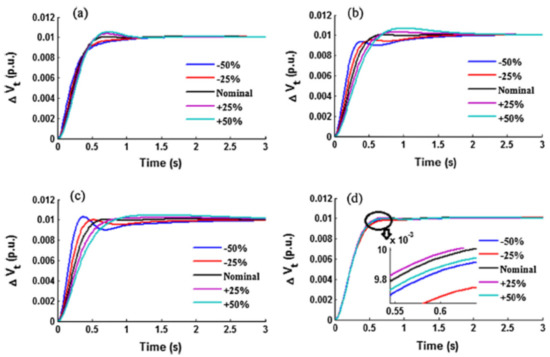
Figure 15.
Step response for the per-unit output voltage variation under different variation of time constants (a) τA (b) τE (c) τG (d) τS “Adapted with permission from Ref. [18]”.
2.6. DCR (Driving Cycle Recognition) and ELP (Electrical Load Perception) Algorithms
The authors [19] designed a power management system based on the bus structure strategy to obtain refined control of vehicle energy. The authors used improved learning vector quantization neural networks and gradient optimization to achieve their goals. In addition, an accurate sliding time-frame online reconnaissance method is designed, and the best time-frame length is determined. The dynamic regulation approach is presented to obtain the optimal fuel consumption for the output power for the alternator and battery. Figure 16 demonstrates the proposed algorithm.

Figure 16.
Transfer function block diagram of the proposed system [19].
In Figure 10, the system consists of an intelligent alternator, an IBS, and an Energy Management Controller (EMC). This arrangement enables the EMC to have real-time information for the driving conditions. The algorithms used in this electrical EMC are DCR and ELP. The EMC should adjust the alternator output voltage dynamically based on the output voltage and output power connection. As the car slows down, the alternator output voltage should be raised to recover and store part of the kinetic energy lost during braking by charging the battery. The electrical load power determines the alternator and battery’s ideal output power, estimated online using ELP. An online electrical energy management strategy based on the DCR and ELP may be developed using the DCR technique based on the neural network and the online electrical energy management strategy with ELP. Figure 17 below illustrates the experimental results using the ELP algorithm.
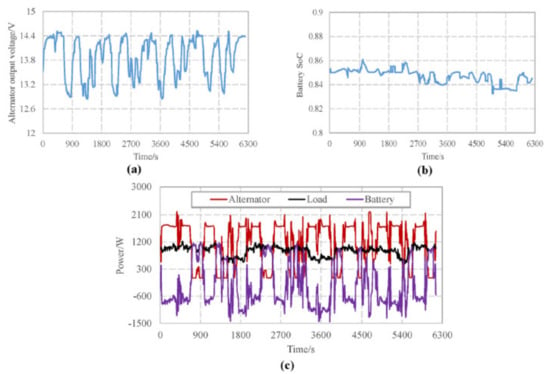
Figure 17.
Experimental results using ELP, (a) output voltage of the alternator, (b) SOC of the battery, and (c) change in power contrast [19].
2.7. Multi-Objective Optimization Approach
Optimization was performed using a multi-objective optimization approach and a physical simulation of a vehicle power network, including energy management and the component behavior [20]. The objective function of the optimization is energy efficiency and minimizing the battery wearing. Two modifiers are introduced to control the power flow; the first is the set point for the comprehensive power Pset, which is the set point for the alternator power. On the other hand, the second modifier is the energy availability of electric vehicles (EV), which indicates the consumer group’s power available percentage. For example, if the EV percentage is set to 80%, the power for the consumers will be reduced by 20%. The algorithm for the EMS is seen in Figure 18.
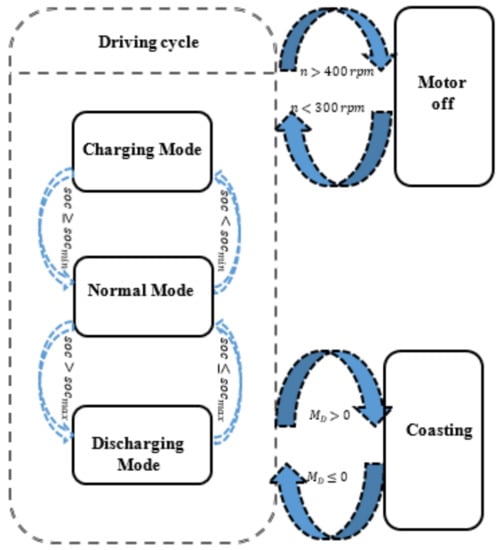
Figure 18.
Algorithm for the proposed optimization approach “Reprinted from Ref. [20]”.
When the alternator efficiency is low, its power will be reduced, while it will be high during its high efficiency, and the power will be stored in the battery. When battery charges are low, the power system enters charge mode, which decreases the consumer’s power consumption by reducing the energy availability modifier and increasing the set power Pset. After the charging is complete, the power will be taken from the battery, and the cycle will be repeated. The optimal sample operating strategy matches the battery current by the engine speed with the alternator’s efficiency.
2.8. Quadratic Optimization
Quadratic optimization theory has been introduced in [21] to solve the problem caused by other optimization strategies in the energy management system and the alternator. An improvement has been made to the classical Quadratic optimization method. The pedal signal is the input torque command for the vehicle, while the battery SOC is regarded as the state variable. The optimization index is designed to solve two issues: the quadratic deviation of actual SOC from the reference value and the fuel consumption rate. The optimal law is introduced by using the solution characteristics of the Riccati and adjoint formulas. This law is related only to one control variable, the power of the battery-motor, which is why it is called a “single degree of freedom quadratic performance index strategy (SQPIS).” The Simulink model for the proposed system is seen in Figure 19.
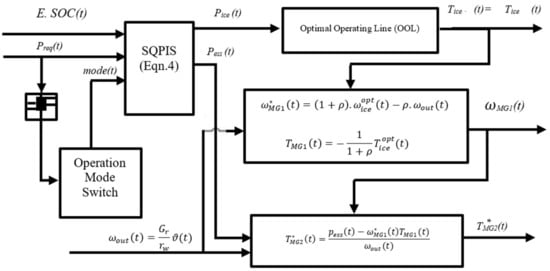
Figure 19.
Simulink model for the proposed optimization algorithm [21].
Figure 20 below represents the simulation result using SQPIS.
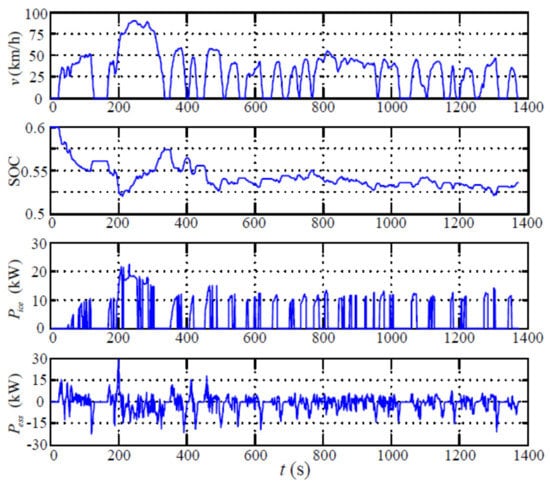
Figure 20.
Simulation result for the SOC, engine power (Pice), and battery-motor system power (Pess) at different speeds values (ν) [21].
2.9. Convex Optimization Algorithm
The new convex optimization algorithm is introduced by [22] to examine the alternator’s power recovery potential. The suggested approach allows the ideal controlling trajectories, e.g., fuel, alternator, and turbine power, and the optimum design parameters, i.e., optimal battery size, alternator, and generator-turbine, to be calculated. Numerical case study modeling for the generator-turbine power train is presented in this work. This paper implements the generator turbine unit (GTU) to increase the engine throttle by obtaining more power via intake airflow to the auxiliary loads.
2.10. Real-Time Energy Management Strategy (R-EMS)
The authors in [23] designed a real-time energy management strategy to control the operation of the power system for the hybrid vehicle. This algorithm did not need previous information about the driving cycle or trip information. Two crucial factors are considered in this work to manage the SOC for the battery—the first one is engine torque, and the second one is its speed. The simulation test is performed on many driving cycles, and the results obtained show that the proposed management system has a significant effect on the SOC for the battery and fuel consumption for the engine. Three PI (proportional-integral) controllers are used to manage the torque for the three above sources, as seen in Figure 21.
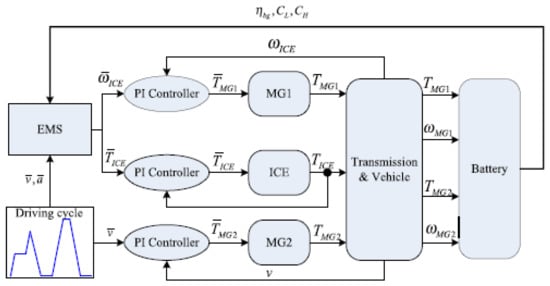
Figure 21.
Control structure of power system for the vehicle [23].
Figure 22 below represents the proposed algorithm’s fuel consumption and the SOC resultant.
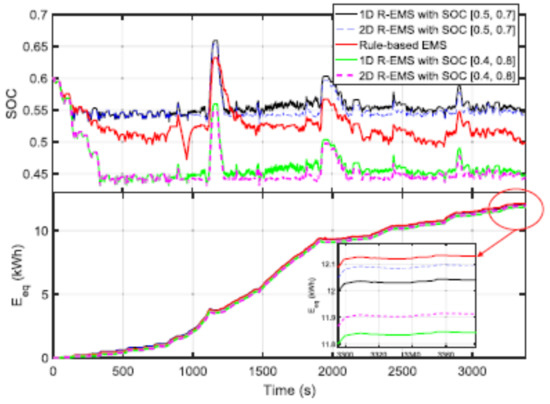
Figure 22.
Simulation results for the SOC and fuel consumption (Eeq) using the proposed algorithm [23].
Furthermore, the author in [24] used a new approach to optimize and automate the operation of the power system in hybrid electric vehicles. This approach is called multidisciplinary design optimization (MDO), at which the determination of the optimal energy management logic is made. Two case studies prove this approach; the first one is used for the configuration of hybrid vehicles. Many optimization approaches (like genetic algorithm (GA), simulated annealing, and pattern search) are used to compare the performance of the feature-based (FB). However, it is found that the proposed method has a run time ten times less using the FB method, but the total cost function is higher as compared with GA. The proposed optimizer is seen in Figure 23.
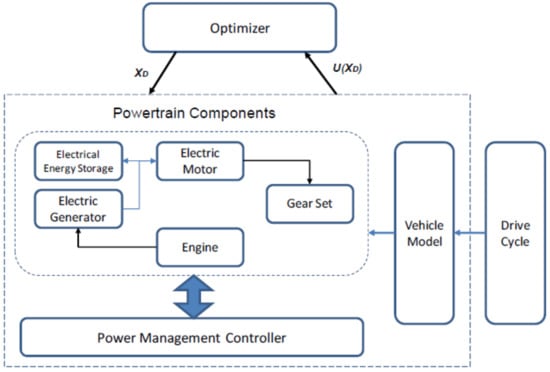
Figure 23.
Case study one for the proposed optimizer [24].
In the other case study, the author deals with a police car optimization of an anti-idling system using the same approach. An additional battery is selected as the goal of the optimization, and a determination of the logic for the power management is used to lower the idling time of the engine. As seen in Figure 24, the optimization system deals with modifying the power system, focusing on running an alternator to produce the auxiliary power for the new battery added to the system that reduces the idling time for the engine. The original battery used for the equipment will not supply the newly added equipment to the vehicle, therefore adding another battery to the system.
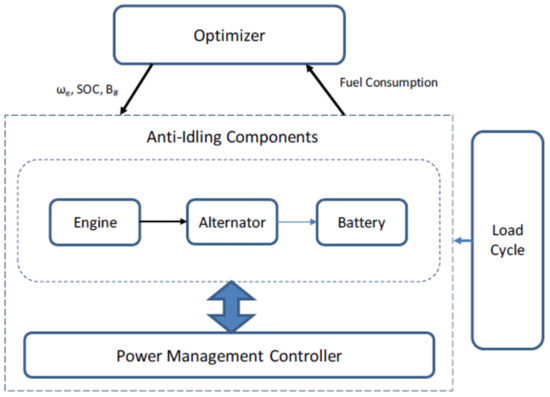
Figure 24.
Case study two for the proposed optimizer [24].
The authors in [25] suggested new control mythology to overcome the disadvantages of manufacturing defects, space problems, and constructive issues, and to increase the power generated by automotive Lundell alternators. Firstly, they replaced the passive rectifier used in the alternator with the semi-active switch mode-controlled rectifier and then implemented a novel controller to track the maximum power point for the alternator. The first method used is model-based optimization to perform maximum power point tracking, and the results indicated that this method is fast, but it is also unreliable due to the simplification in the controller model. Then, a mixed approach is applied to the system, which consists of a model-based tracker with Extremum Seeking Control optimization and load matching real-time technology. The simulation block diagram for the proposed system is seen in Figure 25.
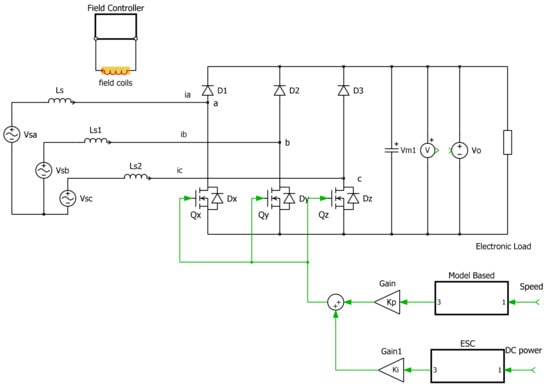
Figure 25.
Proposed hybrid optimization circuit “Reprinted from [25]”.
Furthermore, the authors [26] designed a hybrid optimization controller mixed between sliding mode multi-surface optimization and extremum seeking controller to extract maximum power from the automotive alternator. In addition, the multiple sliding surface approach is developed to make the sliding-mode control more resistant to alternator uncertainties. The suggested concept enables the system to reach the next sliding surface as quickly as feasible, reducing chattering. MPPT simulations have been run in the face of both structured and unstructured uncertainty to demonstrate the efficacy of the proposed controller. Compared to a typical sliding-mode ESC (Extremum Seeking Control), the suggested controller has a more remarkable performance, can respond to system changes faster, and produces a smoother and more accurate response. The system behavior was analyzed using the Lyapunov-like, and the simulation results illustrate that the proposed system has high efficiency. The proposed controller is seen in Figure 26.
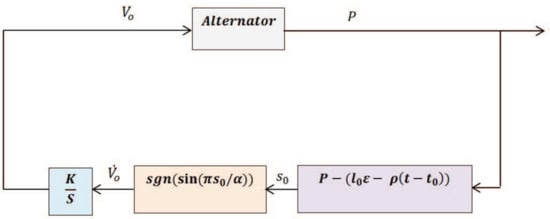
Figure 26.
Proposed multi-surface sliding mode ESC block diagram “Adapted with permission from Ref. [26]”.
The alternator output voltage is regulated to get the maximum power at 1300 rpm speed, and at this speed, the total output power is 700 Watt. The purpose of the feedback loop is to select the nearest sliding surface, then diffraction for the load voltage is generated through the controller function. Finally, this value is integrated and fed to the alternator to get the maximum power output.
Figure 27 below represents the step response for the alternator when applying the multi-surface algorithm.
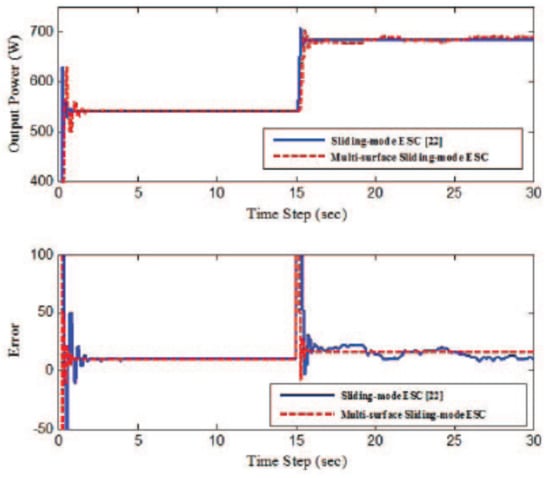
Figure 27.
Step response for the alternator when applying the multi-surface algorithm “Adapted from [26]”.
Moreover, hybrid ESC is used with multi-variable sliding mode optimization by the authors [27]. The suggested controller provides the benefits of sliding-mode control and multi-variable extremum seeking. The multi-variable extremum seeking control removes a control model and enhances controller efficiency. In this work, the authors extract the maximum power from the alternator at low-speed operation with the help of the SMR (switch mode rectifier) load matching method. Figure 28 illustrates the Matlab Simulink for the controller block diagram.
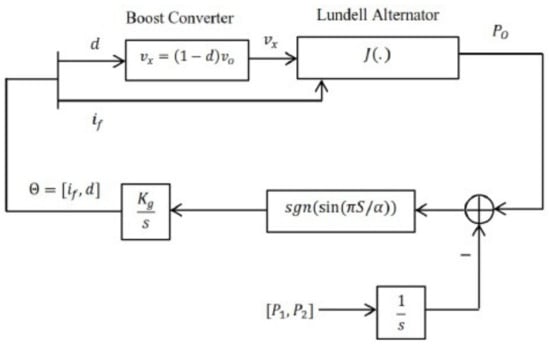
Figure 28.
Proposed multivariable sliding mode ESC “Adapted with permission from [27]”.
The error signal S is obtained by deriving the gradient vector; then, the error is fed to the sgn block; the next step is to get [if, d]. Finally, d is provided to the converter as an update value for the duty cycle to change the output voltage according to the load demand. Meanwhile, the field current will be fed to the alternator to change the output voltage. Similar to the above work, the authors [28] designed an experimental setup circuit that used the multi-variable sliding mode ESC algorithm. Instead of using one PWM (Pulse Width Modulation) for the boost converter, the author added another PWM controller to the field circuit regulator of the alternator as a buck converter. The schematic diagram for the proposed circuit is illustrated in Figure 29.

Figure 29.
Block diagram for the proposed control circuit “Adapted with permission from [28]”.
Figure 30 is for the real-time experimental circuit diagram for the proposed system.
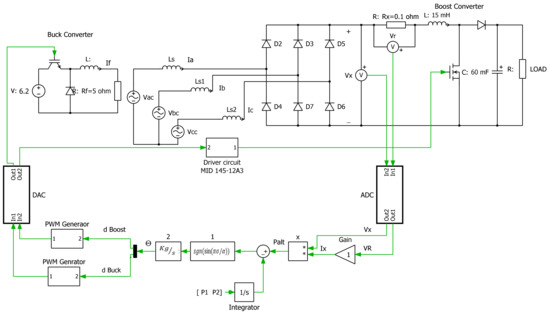
Figure 30.
Experimental setup for the real-time circuit “Reprinted and adapted with permission from [28]”.
Figure 31 represents the converter’s output power when applying the proposed algorithm. Table 2 summarizes the effects of each approach presented in this section.
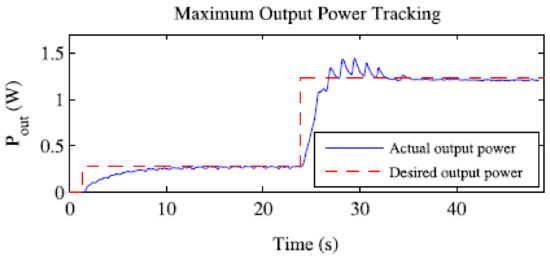
Figure 31.
Output power for the converter “Adapted with permission from [28]”.

Table 2.
Summary of the Optimization Techniques Used in the Alternator.
3. Optimization Using Power Electronic Techniques
In their thesis [29] and papers [30,31,32,33], the authors designed a control circuit for extracting maximum power from an Interior Permanent Magnet (PM) synchronous machine using SMR for automotive applications. In their work, the author justifies their selection for this type of alternator by using it as a current source that provides sufficient power to the load at a wide range of speeds (600–6000 rpm), and it is optimized for field weakening performance. In addition, this type of rectifier improved the output power by 66%. The essential idea is to extract the maximum power at the vehicle’s idle speed. PIC30F10 microcontroller was used to provide the gating signal to the unique switch for the SMR to adjust the output voltage according to the reference DC voltage, as is seen in Figure 32.
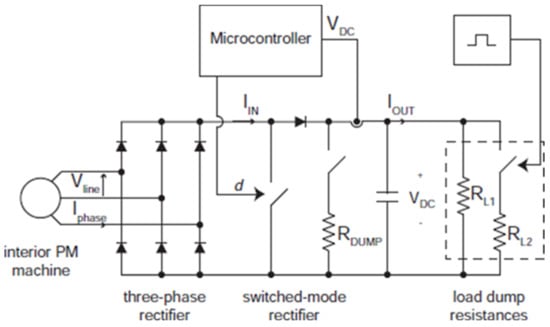
Figure 32.
Closed-loop test for the PM alternator with switched-mode regulator (SMR) [29].
Figure 33 below represents the output power for the alternator using SMR.
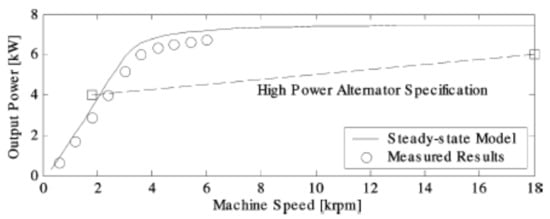
Figure 33.
Output power for PM alternator with switched-mode regulator (SMR) “Adapted with permission from [32]”.
In addition, the authors in [34] designed auxiliary converters for multiple functions to control the alternator’s output. It consists of chargers, inverters, alternators, exciters, and converters of different voltage levels. Moreover, the authors [35] used an induction machine as a stator and alternator and a prototype belt-driven mechanism. An inverter and DC/DC converter were used to optimize the power obtained from the alternator. The authors [36] used a 42-V system to install additional subsystems efficiently. A three-phase 42-V 4-kW automotive power generating induction generator system is suggested. This system employs a low-cost diode rectifier directly linked to the inducing machine to transmit active power to batteries and the load. A new control algorithm is introduced in this work which regulates the output voltage by controlling the PWM inverter. The proposed system is as in Figure 34.
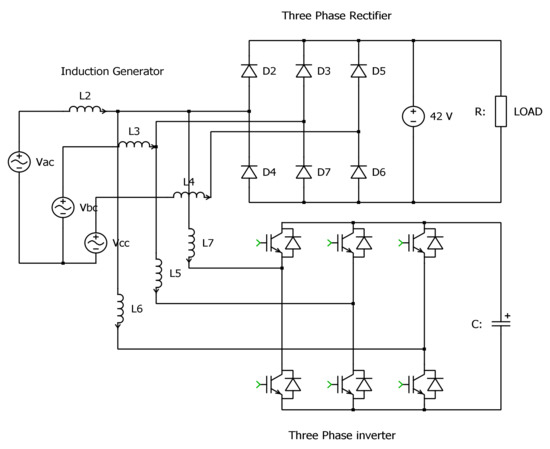
Figure 34.
Induction generator with inverter and bridge rectifier [36].
In addition, the construction of a surface PM alternator was performed in the laboratory by the authors [37] using a single SCR (Silicon-Controlled Rectifier). The rectifier regulates the output voltage and power of the 3.4 kW vehicle alternator at high speed (up to 6500 rpm). The net efficiency of the alternator at high speed was 71% with full load applied. The simple diagram for the variable frequency controller for the SCR bridge rectifier is seen in Figure 35.

Figure 35.
Variable frequency SCR controller block diagram “Reprinted from [37]”.
Results indicate that at low output power (34 A 1445 W) and idle speed of 2150 rpm, the system efficiency was 84.5%, and the output voltage was kept at 42.5-volt. This high efficiency was due to the reduced losses for the rectifier.
Another surface PM starter-alternator combination was designed using Litz winding to minimize copper losses and improve system efficiency at higher speeds. An inverter controlled the output voltage, and the system’s total load efficiency was 96% at 3000 rpm [38]. The block diagram of the system is in Figure 36.
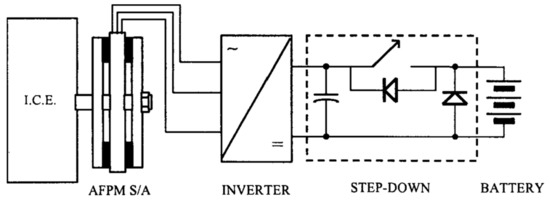
Figure 36.
AFPM connection for the engine and inverter block diagram [38].
Similarly, the authors in [39] used the same axial flux permanent magnet alternator (AFPM) with a fully controlled AC to DC converter. Then, an intelligent controller was designed using an Arduino Uno board that uses an Atmel ATMega328P microcontroller. The controller is responsible for generating the gating signals for the converter using a comparator circuit. Firstly, the system was tested using Matlab Simulink, and then an experimental setup was introduced. The design of the controller depends on measuring the alternator output voltage, then a feedback signal from the battery side and PWM signals will be generated to change the switching sequence for the converter. High efficiency is obtained using the proposed system (94%) and good voltage regulation. A six-step inverter and controller were designed [40] to control the power output of the interior PM. The controllable inverter was synchronized with the alternator according to the output voltage’s zero-crossing data of the third harmonic. The load power is controlled by shifting the voltage to the third harmonic. The control device increases the alternator’s output by 43% with the same alternator as the traditional diode rectifier while the engine is idle and at high ambient temperature.
Because of its good performance and characteristics, the interior PM was also introduced as an alternator in [41]. An investigation of the application of a half-bridge SMR controller to an interior PM was achieved [42,43,44].
The rectifier performs maximum power extraction from the alternator using a new load matching technique. This arrangement allowed increasing the output power linearly from 1 kW at idle speed (1800 rpm) to about 4 kW (6000 rpm). Compared with the congenital diode rectifier, the SMR was increased almost three times (from 1.5 kW to 4 kW). The schematic diagram for the complete circuit with controllers to the field and semi-bridge rectifier is seen in Figure 37.
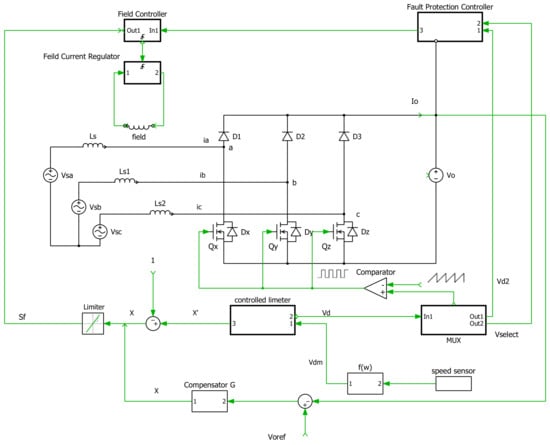
Figure 37.
Controllers for the proposed system “Reprinted from [42]”.
Losses for the electrical power system in the Lundell automotive alternators are studied in [45]. Tests for passive rectifiers used with the brushless interior permanent-magnet (PM) automotive Lundell alternator indicated that 10–12% of the losses are caused by the diode used in the converters. To overcome the complexity and high cost of the inverter, the authors in [46] designed an inverter less for brushless interior permanent magnet automotive alternator using a switched-mode converter. Many advantages have been found when using this type of alternator; firstly, it has high back electromotive voltage with high reluctance. In addition, it performs as a stable current source and has a wide range of operating speeds. A novel generic optimization method is implemented in [47] to calculate the reference signals used to optimize the Lundell alternator efficiency by minimizing the copper losses. This is achieved using an active metal-oxide-semiconductor field-effect transistor (MOSFET) rectifier at the alternator’s output using Matlab Simulink, and then an experimental setup is designed to verify the results. Results indicate high efficiency compared with a system that used a passive rectifier. Figure 38 illustrates the block diagram for the proposed control strategy with the active rectifier.

Figure 38.
Matlab Simulink setup for the alternator, rectifier, and controller “Reprinted from [47]”.
Figure 39 is the experimental setup for the proposed system.
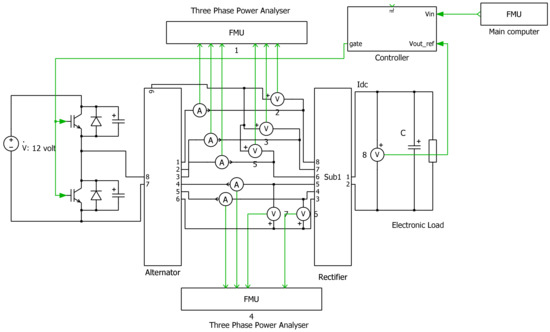
Figure 39.
Experimental setup for the controller and alternator/rectifier “Reprinted from [47]”.
Power electronic is used again in [48] to produce a dual output voltage for the automotive alternator. The authors used SMRs to produce 42-volt and 14-volt outputs from the alternator. A full match for the load is achieved, and the delivered power for the two outputs is performed to any one of the combinations according to the load demand. Results indicated a good response and performance for the proposed combination. Figure 40 illustrates the circuit diagram for the dual output new SMRs.
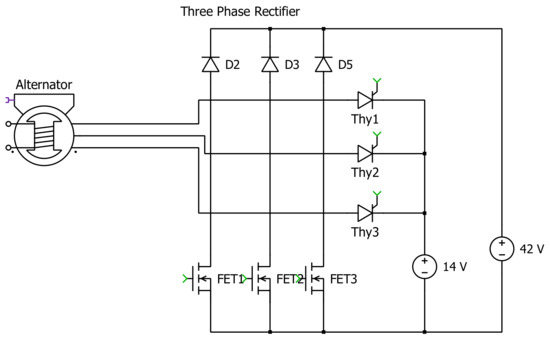
Figure 40.
New dual output SMR circuit diagram “Reprinted from [48]”.
The alternative circuit diagram is in Figure 41.

Figure 41.
Alternative circuit diagram for the SMRs “Reprinted from [48]”.
Novel direct frequency tracking for synchronous rectifier (D-FTSR) is applied in [49]; this method is a practical dependent approach to control the output voltage of the synchronous rectifier connected to the automotive alternator. The D-FT approach is proposed in this article to solve the issue posed by continually and statistically fluctuating switching frequency. The D-FT approach might ensure that the switching tube operates in adaptive safe conduction time (SCT) concerning the rotor speed, preventing circuit oscillation and spurious ringing. The suggested driving circuit delivers accurate gate driving signals without the need for any extra passive circuits or sensors for rotor speed detection. The switching tube may operate like a typical diode with this driver, increasing the SR’s suitability for multiphase systems in automobile alternators. The schematic diagram for the direct frequency tracing is seen in Figure 42, while Figure 43 presents the flowchart for the D-FT algorithm.
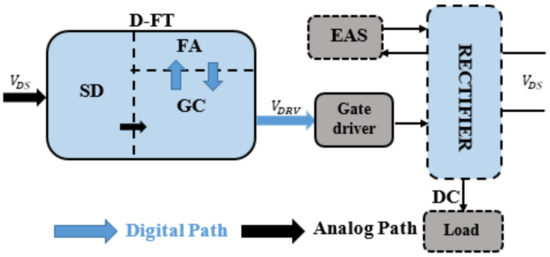
Figure 42.
The schematic diagram for the direct frequency tracing “Reprinted from [49]”.
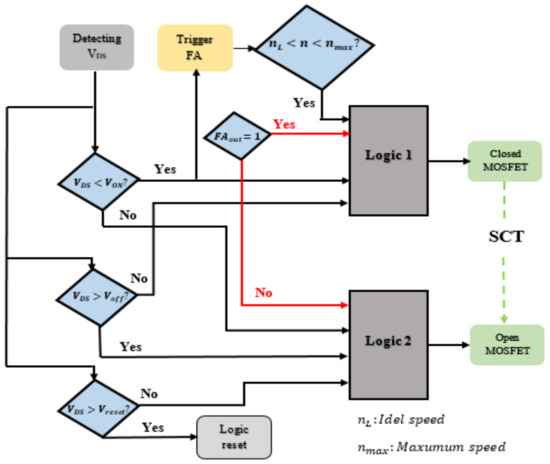
Figure 43.
Flowchart for the D-FT algorithm “Reprinted from [49]”.
Finally, a summary of the advantage and disadvantages of the power electronic devices used to enhance and optimize the alternator performance is in Table 3 below.

Table 3.
Summary of Power Electronic Devices Effects on the Alternator Performance.
4. Conclusions
Many optimization techniques and approaches for the automotive alternator are presented in this work. Each approach’s principle and effect are explained, discussed, and analyzed. The optimization methods presented in this work can be divided into many techniques; that is, approaches deal with optimizing the output power of the alternator and using the power electronic devices with some suitable controllers to force the alternator to produce the maximum power. Some optimization techniques deal with the alternator’s execution current only; others control the alternator’s output voltage. The most suitable and robust approach simultaneously maintains the excitation current and the alternator’s output voltage. Although the last technique requires complex control and optimization tools, it enhances the alternator’s efficiency and reduces the fuel consumption of the ICE. Some of these methods cannot be applied in a real-time manner, but the methods that are applicable in real-time give the most accurate results, and hence it gives a self-optimization to the alternator during its operating cycle. The powerful and most suitable technique is using Multi-Variable Sliding-mode Extremum Seeking because it enhances the alternator’s efficiency and performs in a real-time manner with high accuracy.
Author Contributions
Conceptualization, O.T.M.; Data curation, L.I.I. and S.S.; Formal analysis, O.T.M., L.I.I., S.S. and N.A.; Funding acquisition, W.Z.W.H.; Investigation, O.T.M., W.Z.W.H., L.I.I., S.S. and N.M.H.N.; Project administration, W.Z.W.H.; Resources, O.T.M. and N.M.H.N.; Supervision, W.Z.W.H. and L.I.I.; Validation, W.Z.W.H.; Writing—original draft, N.A. All authors have read and agreed to the published version of the manuscript.
Funding
This research was fully funded by the Universiti Putra Malaysia (UPM) under a research grant—(Putra Grant UPM, GP-IPB/2020/9687801).
Institutional Review Board Statement
Not applicable.
Informed Consent Statement
Informed consent was obtained from all subjects involved in the study.
Data Availability Statement
The data presented in this study are available on request from the corresponding author. The data are not publicly available due to privacy concerns.
Acknowledgments
The authors would like to thank the Malaysia Ministry of Higher Education University of Putra Malaysia for supporting this work.
Conflicts of Interest
The authors declare no conflict of interest.
References
- Mazlan, R.K.; Dan, R.M.; Zakaria, M.Z.; Hamid, A.H.A. Experimental study on the effect of alternator speed to the car charging system. MATEC Web Conf. 2016, 90, 1076. [Google Scholar] [CrossRef] [Green Version]
- Ali, H.; Sulaiman, E.; Aziz, R.; Jenal, M.; Ahmad, M.Z.; Khan, F. Review of Double Stator Flux switching machines with various arrangements of excitation sources. Alex. Eng. J. 2021, 60, 4393–4410. [Google Scholar] [CrossRef]
- Chiara, F.; Canova, M. A review of energy consumption, management, and recovery in automotive systems, with considerations of future trends. Proc. Inst. Mech. Eng. Part D J. Automob. Eng. 2013, 227, 914–936. [Google Scholar] [CrossRef]
- Gecha, V.Y.; Goncharov, V.I.; Chirkin, V.G.; Shirinskii, S.V.; Petrichenko, D.A. Linear Alternator with Reciprocating Mover: Review of Designs and Machine Types. Biosci. Biotechnol. Res. Asia 2015, 12, 409–418. [Google Scholar] [CrossRef]
- Kamalakannan, C.; Kamaraj, V.; Paramasivam, S.; Paranjothi, S.R. Switched Reluctance Machine in Automotive Applications A Technology Status Review. In Proceedings of the 1st International Conference on Electrical Energy Systems, Chennai, India, 3–5 January 2011; pp. 187–197. [Google Scholar] [CrossRef]
- Li, S.; Zhang, S.; Habetler, T.G.; Harley, R.G. Modeling, Design Optimization, and Applications of Switched Reluctance Machines—A Review. IEEE Trans. Ind. Appl. 2019, 55, 2660–2681. [Google Scholar] [CrossRef]
- Rahman, S.A.; Masjuki, H.; Kalam, M.; Abedin, M.; Sanjid, A.; Sajjad, H. Impact of idling on fuel consumption and exhaust emissions and available idle-reduction technologies for diesel vehicles—A review. Energy Convers. Manag. 2013, 74, 171–182. [Google Scholar] [CrossRef]
- Reddy, K.J.; Natarajan, S. Energy sources and multi-input DC-DC converters used in hybrid electric vehicle applications—A review. Int. J. Hydrogen Energy 2018, 43, 17387–17408. [Google Scholar] [CrossRef]
- Boldea, I. Automobile Electrification Trends: A Review. In Proceedings of the 2007 International Aegean Conference on Electrical Machines and Power Electronics, Bodrum, Turkey, 10–12 September 2007; pp. 369–377. [Google Scholar] [CrossRef]
- Saponara, S.; Lee, C.H.; Wang, N.X.; Kirtley, J.L. Electric Drives and Power Chargers: Recent Solutions to Improve Performance and Energy Efficiency for Hybrid and Fully Electric Vehicles. IEEE Veh. Technol. Mag. 2020, 15, 73–83. [Google Scholar] [CrossRef]
- Gathadi, P.; Bhole, A. Electric Motors and Rotor Position Detection Techniques of Integrated Starter Alternator for HEV: A Review. In Proceedings of the 2018 International Conference on Current Trends towards Converging Technologies (ICCTCT), Coimbatore, India, 1–3 March 2018; pp. 1–6. [Google Scholar] [CrossRef]
- Enang, W.; Bannister, C. Modelling and control of hybrid electric vehicles (A comprehensive review). Renew. Sustain. Energy Rev. 2017, 74, 1210–1239. [Google Scholar] [CrossRef] [Green Version]
- Waldman, C.; Gurusubramanian, S.; Fiorentini, L.; Canova, M. A model-based supervisory energy management strategy for a 12 V vehicle electrical system. Control Eng. Pr. 2015, 44, 20–30. [Google Scholar] [CrossRef] [Green Version]
- Wang, Y.; Hu, H.; Zhang, L.; Zhang, N.; Sun, X. Real-Time Vehicle Energy Management System Based on Optimized Distribution of Electrical Load Power. Appl. Sci. 2016, 6, 285. [Google Scholar] [CrossRef] [Green Version]
- Couch, J.; Fiorentini, L.; Canova, M. An ECMS-Based Approach for the Energy Management of a Vehicle Electrical System. IFAC Proc. Vol. 2013, 46, 115–120. [Google Scholar] [CrossRef]
- Koot, M.; Kessels, J.T.; de Jager, B.; Heemels, W.P.M.H.; van den Bosch, P.P.J.; Steinbuch, M. Energy management strategies for vehicular electric power systems. IEEE Trans. Veh. Technol. 2005, 54, 771–782. [Google Scholar] [CrossRef]
- Han, Z.; Hu, Y.; Sun, P.; Chen, H. Model Predictive Control of Diesel Engine Start-Stop Control in an HEV. In Proceedings of the 36th Chinese Control Conference (CCC), Dalian, China, 26–28 July 2017. [Google Scholar] [CrossRef]
- Chatterjee, S.; Mukherjee, V. PID controller for automatic voltage regulator using teaching–learning based optimization technique. Int. J. Electr. Power Energy Syst. 2016, 77, 418–429. [Google Scholar] [CrossRef]
- Wang, Y.; Zhang, N.; Wu, Y.; Liu, B.; Wu, Y. A strategy of electrical energy management for internal combustion engine vehicle based on driving cycle recognition and electrical load perception. Adv. Mech. Eng. 2018, 10, 1687814018809236. [Google Scholar] [CrossRef]
- Winter, M.; Taube, J.; Herzog, H.-G. Simulation-Based Optimization of an Energy Management for Automotive Power Nets. In Proceedings of the IEEE International Conference on Electrical Systems for Aircraft, Railway, Ship Propulsion and Road Vehicles & International Transportation Electrification Conference (ESARS-ITEC), Nottingham, UK, 7–9 November 2018 ; pp. 1–5. [Google Scholar] [CrossRef]
- Xia, C.; Du, Z.; Zhang, C. A Single-Degree-of-Freedom Energy Optimization Strategy for Power-Split Hybrid Electric Vehicles. Energies 2017, 10, 896. [Google Scholar] [CrossRef] [Green Version]
- Marinkov, S.; Murgovski, N.; de Jager, B. Convex Modeling and Optimization of a Vehicle Powertrain Equipped with a Generator-Turbine Throttle Unit. IEEE Trans. Control Syst. Technol. 2016, 25, 1–14. [Google Scholar] [CrossRef]
- Wu, J.; Ruan, J.; Zhang, N.; Walker, P.D. An Optimized Real-Time Energy Management Strategy for the Power-Split Hybrid Electric Vehicles. IEEE Trans. Control Syst. Technol. 2018, 27, 1194–1202. [Google Scholar] [CrossRef]
- Fan, B.S.M. Multidisciplinary Optimization of Hybrid Electric Vehicles: Component Sizing and Power Management Logic. Ph.D. Thesis, University of Waterloo, Waterloo, ON, Canada, 2011; pp. 1–146. Available online: http://resonance.uwaterloo.ca/p/alumni/thesis/b-fan-T.pdf (accessed on 26 May 2019).
- Rodrigues, G.S.L.; Oliveira, A.C.; Lima, A.M.N. Combining Model-Based and Extremum Seeking Control for Fast Tracking the Maximum Power Point of Lundell Alternator. In Proceedings of the 15th Brazilian Power Electronics Conference and 5th IEEE Southern Power Electronics Conference (COBEP/SPEC), Santos, Brazil, 1–4 December 2019; pp. 1–6. [Google Scholar] [CrossRef]
- Toloue, S.F.; Moallem, M. A Multi-Surface Sliding-Mode Extremum Seeking Controller for Alternator Maximum Power Point Tracking. In Proceedings of the IECON 2015 - 41st Annual Conference of the IEEE Industrial Electronics Society, Yokohama, Japan, 9–12 November 2015; pp. 001501–001506. [Google Scholar] [CrossRef]
- Tolue, S.F.; Moallem, M. Multivariable Sliding-Mode Extremum Seeking Control with Application to Alternator Maximum Power Point Tracking. In Proceedings of the IECON 2016—42nd Annual Conference of the IEEE Industrial Electronics Society, Florence, Italy, 23–26 October 2016; pp. 229–234. [Google Scholar] [CrossRef]
- Toloue, S.F.; Moallem, M. Multivariable Sliding-Mode Extremum Seeking Control with Application to MPPT of an Alternator-Based Energy Conversion System. IEEE Trans. Ind. Electron. 2017, 64, 6383–6391. [Google Scholar] [CrossRef]
- Liaw, C.Z. A High Power Interior Permanent Magnet Alternator for Automotive Applications. 2013. Available online: https://digital.library.adelaide.edu.au/dspace/bitstream/2440/83587/8/02whole.pdf (accessed on 23 February 2022).
- Liaw, C.-Z.; Whaley, D.; Soong, W.; Ertugrul, N. Investigation of inverterless control of interior permanent-magnet alternators. IEEE Trans. Ind. Appl. 2006, 42, 536–544. [Google Scholar] [CrossRef] [Green Version]
- Liaw, C.; Soong, W.; Ertugrul, N. Closed-Loop Control and Performance of an Inverterless Interior PM Automotive Alternator. In Proceedings of the International Conference on Power Electronics and Drives Systems, Kuala Lumpur, Malaysia, 28 November–1 December 2005; Voulme 1, pp. 343–348. [Google Scholar] [CrossRef]
- Liaw, C.-Z.; Soong, W.L.; Welchko, B.A.; Ertugrul, N. Uncontrolled Generation in Interior Permanent-Magnet Machines. IEEE Trans. Ind. Appl. 2005, 41, 945–954. [Google Scholar] [CrossRef] [Green Version]
- Liaw, C.; Soong, W.; Ertugrul, N. Low-Speed Output Power Improvement of an Interior PM Automotive Alternator. In Proceedings of the Conference Record of the 2006 IEEE Industry Applications Conference Forty-First IAS Annual Meeting, Tampa, FL, USA, 8–12 October 2006; Volume 1, pp. 27–34. [Google Scholar] [CrossRef]
- Ilončiak, J.; Struharnanský, Ľ.; Kuchta, J. Modular Concept of Auxiliary Converters for Diesel Electric Locomotives. Procedia Eng. 2017, 192, 359–364. [Google Scholar] [CrossRef]
- Henry, R.R.; Lequesne, B.; Chen, S.; Ronning, J.J.; Xue, Y. Belt-Driven Starter-Generator for Future 42-Volt Systems; (No. 2001-01-0728); SAE Technical Paper; SAE International: Warrendale, PA, USA, 2001. [Google Scholar]
- Naidu, M.; Walters, J. A 4-kW 42-V induction-machine-based automotive power generation system with a diode bridge rectifier and a PWM inverter. IEEE Trans. Ind. Appl. 2003, 39, 1287–1293. [Google Scholar] [CrossRef]
- Naidu, M.; Henry, R.; Boules, N. A 3.4 kW, 42 V High Efficiency Automotive Power Generation System; SAE International: Warrendale, PA, USA, 2000. [Google Scholar] [CrossRef]
- Caricchi, F.; Crescimbini, F.; Santini, E.; Solero, L. High-efficiency low-volume starter/alternator for automotive applications. In Proceedings of the Conference Record of the 2000 IEEE Industry Applications Conference. Thirty-Fifth IAS Annual Meeting and World Conference on Industrial Applications of Electrical Energy (Cat. No. 00CH37129), Rome, Italy, 8–12 October 2000; Volume 1. [Google Scholar]
- El-Hasan, T.S. Development of Automotive Permanent Magnet Alternator with Fully Controlled AC/DC Converter. Energies 2018, 11, 274. [Google Scholar] [CrossRef] [Green Version]
- Liang, F.; Miller, J.; Zarei, S. A control scheme to maximize output power of a synchronous alternator in a vehicle electrical power generation system. In Proceedings of the IAS ‘96. Conference Record of the 1996 IEEE Industry Applications Conference Thirty-First IAS Annual Meeting, San Diego, CA, USA, 6–10 October 1996. [Google Scholar] [CrossRef]
- Lovelace, E.; Jahns, T.; Lang, J.H. Impact of saturation and inverter cost on interior PM synchronous machine drive optimization. IEEE Trans. Ind. Appl. 2000, 36, 723–729. [Google Scholar] [CrossRef]
- Perreault, D.; Caliskan, V. Automotive Power Generation and Control. IEEE Trans. Power Electron. 2004, 19, 618–630. [Google Scholar] [CrossRef]
- Rivas, J.M.; Perreault, D.J.; Keim, T.A. Performance Improvement of Alternators with Switched-Mode Rectifiers. IEEE Trans. Energy Convers. 2004, 19, 561–568. [Google Scholar] [CrossRef]
- Rivas, J. Output Power Increase at Idle Speed in Alternators. Ph.D. Thesis, Massachusetts Institute of Technology, Cambridge, MA, USA, 2003. [Google Scholar]
- Sarafianos, D.; Logan, T.G.; McMahon, R.A.; Flack, T.J.; Pickering, S. Alternator Loss Breakdown and Use of Alternative Rectifier Diodes for Improvement of Vehicle Electrical Power System Efficiency. In Proceedings of the 16th International Power Electronics and Motion Control Conference and Exposition, Antalya, Turkey, 21–24 September 2014; pp. 502–507. [Google Scholar] [CrossRef]
- Soong, W.; Ertugrul, N. Inverterless High-Power Interior Permanent-Magnet Automotive Alternator. IEEE Trans. Ind. Appl. 2004, 40, 1083–1091. [Google Scholar] [CrossRef]
- Sarafianos, D.; Llano, D.X.; Ghosh, S.S.; McMahon, R.A.; Pickering, S.; Flack, T.J. Control Strategy for a Multiphase Lundell-Alternator/Active-Rectifier System in 14 V Automotive Power Systems. IEEE Trans. Transp. Electrif. 2019, 5, 347–355. [Google Scholar] [CrossRef]
- Hassan, G.; Perreault, D.; Keim, T. Design of Dual-Output Alternators with Switched-Mode Rectification. IEEE Trans. Power Electron. 2005, 20, 164–172. [Google Scholar] [CrossRef]
- Wan, J.; Zeng, X.; Li, Z.; Li, L.; Yang, Y.; Zhao, Y.; Li, Z.; Zhang, B. A Novel Synchronous Rectification with Directly Frequency Tracking for Automotive Alternator. IEEE Trans. Ind. Electron. 2021, 69, 2216–2226. [Google Scholar] [CrossRef]
Publisher’s Note: MDPI stays neutral with regard to jurisdictional claims in published maps and institutional affiliations. |
© 2022 by the authors. Licensee MDPI, Basel, Switzerland. This article is an open access article distributed under the terms and conditions of the Creative Commons Attribution (CC BY) license (https://creativecommons.org/licenses/by/4.0/).